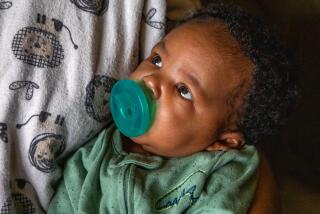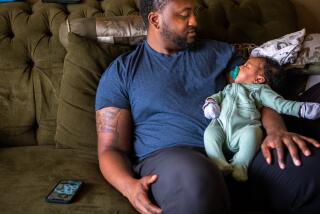Crib Death Risk, Secondhand Smoke Linked
- Share via
Consistent exposure to secondhand smoke can sharply increase the risk of sudden infant death syndrome, the unexpected, unexplained death of a child under the age of 1, according to UC San Diego researchers.
Preventive medicine specialist Hillary Sandra Klonoff-Cohen and her colleagues at UCSD studied 200 SIDS cases in five Southern California counties between 1989 and 1992 and compared them to 200 carefully matched healthy infants born on the same days.
They report today in the Journal of the American Medical Assn. that children in homes where one or more adults smoked during the pregnancy and after birth were 2.2 to 5.3 times as likely to die from SIDS and that the risk increased with the amount of exposure.
Infants exposed to one to 10 cigarettes per day were 2.4 times as likely to die of SIDS as unexposed infants, while those exposed to 11 to 20 per day were 3.6 times as likely to die. In the worst case, infants exposed to more than 21 cigarettes per day were 23 times as likely to die as those not exposed.
SIDS, also known as crib death, is the most common cause of mortality among infants under age 1, accounting for as many as 6,000 deaths in the United States each year. The deaths, most of which occur between the ages of 2 and 4 months, are particularly shocking to parents because they come without warning and without apparent cause.
Based on this and other studies, said Marian Willinger of the National Institute of Child Health and Human Development, “It is imperative that all health care professionals in contact with the family (of a newborn) strongly advocate smoking cessation.”
But some researchers cautioned that secondhand smoke is simply a risk factor and that there is an underlying cause of SIDS--perhaps biological or genetic--that has yet to be identified. Phipps Y. Cohe of the SIDS Alliance in Columbia, Md., said secondhand smoke “poses an increased challenge to a baby who is already vulnerable” for reasons that are not yet understood.
Scientists believe there are a number of of risk factors for SIDS, including being male (60% of deaths are among males), being born premature, having a teen-age mother and living in poverty.
One of the most important risk factors is for the baby to sleep in a prone position--on its stomach. Many studies have shown a strong link between sleep position and SIDS and, in 1992, the American Academy of Pediatrics and other groups began encouraging parents of newborns to routinely place them on their backs or sides.
Such campaigns have led to a reduction in the incidence of SIDS in several countries, including Australia, New Zealand and England. A second report in today’s medical association journal from researchers in Tasmania demonstrated that the incidence of SIDS dropped by more than half after an intensive publicity campaign that sharply reduced the number of children sleeping in the prone position.
Surprisingly, a third paper, also by Klonoff-Cohen and her associates, found no link to sleep position among the Southern California infants. “This is the first study that has looked for such an association and didn’t find it,” Brooks said. “We’re not sure why they didn’t find it.”
But Klonoff-Cohen noted that other studies of prone sleeping found that most deaths occurred during cold winter months and that they were also associated with bundling of the babies for warmth, bedding of sheepskin and similar materials, and high room temperatures from central heating. Those factors are rare in this region, she said.
The smoking results were much more clear cut. Children whose mothers smoked were 2.28 times as likely to die from SIDS as those in a smoke-free house, and those whose father smoked were 3.46 times as likely to die. If an adult in the house other than a parent smoked, the children were 2.18 times as likely to die. If two or more adults smoked, the risk was 5.3 times as high as in a nonsmoking household.
Previous studies have shown that breast feeding protects against SIDS, and the UCSD research confirmed that. Breast-fed infants in nonsmoking households had only one-third the risk of SIDS as formula-fed infants in similar households. But if the mother smoked, that protective effect was completely lost.
Klonoff-Cohen noted that about two-thirds of SIDS deaths occur in children with no obvious risk factors.
Said the SIDS Alliance’s Cohe, “We need to have a much better understanding of what actually causes SIDS before we can understand how these risk factors work.”






